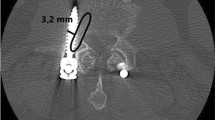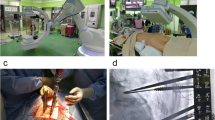Abstract
Background
Computed tomographic (CT) based navigation is a technique to improve the accuracy of pedicle screw placement. It is believed to enhance accuracy of pedicle screw placement, potentially avoiding complications arising due to pedicle wall breach. This study aims to assess the results of dorsolumbar fractures operated by this technique.
Materials and Methods
Thirty consecutive skeletally mature patients of fractures of dorsolumbar spine (T9–L5) were subjected to an optoelectronic navigation system. All patients were thoroughly examined for neurological deficit. The criterion for instability were either a tricolumnar injury or presence of neurological deficit or both. Patients with multilevel fractures and distorted spine were excluded from study. Time taken for insertion of each pedicle screw was recorded and placement assessed with a postoperative CT scan using Laine’s grading system.
Results
Only one screw out of a total of 118 screws was misplaced with a Laine’s Grade 5 placement, showing a misplacement rate of 0.847%. Average time for matching was 7.8 min (range 5–12 min). Average time taken for insertion of a single screw was 4.19 min (range 2–8 min) and total time for all screws after exposure was 34.23 min (range 24–45 min) for a four screw construct. No neurovascular complications were seen in any of the patients postoperatively and in subsequent followup of 1‑year duration.
Conclusion
CT‑based navigation is effective in improving accuracy of pedicle screw placement in traumatic injuries of dorsolumbar spine (T9–L5), however additional cost of procuring CT scan to the patient and cost of equipment is of significant concern in developing countries. Reduced radiation exposure and lowered ergonomic constraints around the operation table are its additional benefits.
Similar content being viewed by others
References
Gaines RW Jr. The use of pedicle-screw internal fixation for the operative treatment of spinal disorders. J Bone Joint Surg Am 2000;82-A:1458–76.
Denis F. The three column spine and its significance in the classification of acute thoracolumbar spinal injuries. Spine (Phila Pa 1976) 1983;8:817–31.
Yahiro MA. Comprehensive literature review. Pedicle screw fixation devices. Spine (Phila Pa 1976) 1994;19:2274–8S.
Mirkovic S, Abitbol JJ, Steinmann J, Edwards CC, Garfin SR. Anatomic considerations for sacral screw placement. Orthop Trans 1991;15:235–6.
Amiot LP, Lang K, Putzier M, Zippel H, Labelle H. Comparative results between conventional and computer-assisted pedicle screw installation in the thoracic, lumbar, and sacral spine. Spine (Phila Pa 1976) 2000;25:606–14.
Castro WH, Halm H, Jerosch J, Malms J, Steinbeck J, Blasius S. Accuracy of pedicle screw placement in lumbar vertebrae. Spine 1996;21:1320–4.
Laine T, Schlenzka D, Mäkitalo K, Tallroth K, Nolte LP, Visarius H. Improved accuracy of pedicle screw insertion with computer-assisted surgery. A prospective clinical trial of 30 patients. Spine (Phila Pa 1976) 1997;22:1254–8.
Merloz P, Tonetti J, Pittet L, Coulomb M, Lavalleé S, Sautot P. Pedicle screw placement using image-guided techniques. Clin Orthop Relat Res 1998;(354):39–48.
Schulze CJ, Munzinger E, Weber U. Clinical relevance of accuracy of pedicle screw placement. A computed tomographic-supported analysis. Spine (Phila Pa 1976) 1998;23:2215–20.
Vaccaro AR, Rizzolo SJ, Allardyce TJ, Ramsey M, Salvo J, Balderston RA, et al. Placement of pedicle screws in the thoracic spine. Part I: Morphometric analysis of the thoracic vertebrae. J Bone Joint Surg Am 1995;77:1193–9.
Datir SP, Mitra SR. Morphometric study of the thoracic vertebral pedicle in an Indian population. Spine (Phila Pa 1976) 2004;29:1174–81.
Merloz P, Tonetti J, Eid A, Faure C, Lavallee S, Troccaz J, et al. Computer-assisted spine surgery. Clin Orthop Relat Res 1997;(337):86–96.
Schlenzka D, Laine T, Lund T. Computer-assisted spine surgery. Eur Spine J 2000;9 Suppl 1:S57–64.
Nolte LP, Slomczykowski MA, Berlemann U, Strauss MJ, Hofstetter R, Schlenzka D, et al. A new approach to computer-aided spine surgery: Fluoroscopy-based surgical navigation. Eur Spine J 2000;9 Suppl 1:S78–88.
Kalfas IH, Kormos DW, Murphy MA, McKenzie RL, Barnett GH, Bell GR, et al. Application of frameless stereotaxy to pedicle screw fixation of the spine. J Neurosurg 1995;83:641–7.
Fu TS, Chen LH, Wong CB, Lai PL, Tsai TT, Niu CC, et al. Computer-assisted fluoroscopic navigation of pedicle screw insertion: An in vivo feasibility study. Acta Orthop Scand 2004;75:730–5.
Rajasekaran S, Vidyadhara S, Ramesh P, Shetty AP. Randomized clinical study to compare the accuracy of navigated and nonnavigated thoracic pedicle screws in deformity correction surgeries. Spine (Phila Pa 1976) 2007;32:E56–64.
Jaiswal A, Shetty AP, Rajasekaran S. Role of intraoperative Iso-C based navigation in challenging spine trauma. Indian J Orthop 2007;41:312–7.
Laine T, Lund Y, Likoski M, Schlenzka D, Lohikoski J. Accuracy of pedicle screw insertion with and without computer assistance: A prospective randomized controlled clinical trial of 46 patients. International Society for the Study of Lumbar Spine, 26th Meeting, Kona Hawaii June, 1999. p. 21–5.
Amiot L.P, Lang K, Putzier M, Lang K, Zippel H. Comparative results between conventional and computer-assisted pedicle screw insertion in the thoracic, lumbar, and sacral spine. Spine 2000;25:606–614.
Ebmeier K, Haberland N, Kalff RL. Spinal navigation in combination with intraoperative computed tomography. Computer AssistedOrthopaedic Surgery, Fourth International Symposium, Davos, 17–19 March 1999.
McAfee PC, Yuan HA, Fredrickson BE, Lubicky JP. The value of computed tomography in thoracolumbar fractures. An analysis of one hundred consecutive cases and a new classification. J Bone Joint Surg Am 1983;65:461–73.
Foley KT, Simon DA, Rampersaud YR. Virtual fluoroscopy: Computer-assisted fluoroscopic navigation. Spine (Phila Pa 1976) 2001;26:347–51.
Weidner A, Wähler M, Chiu ST, Ullrich CG. Modification of C1-C2 transarticular screw fixation by image-guided surgery. Spine (Phila Pa 1976) 2000;25:2668–73.
Wang HC, Yang YL, Lin WC, Chen WF, Yang TM, Lin YJ, et al. Computer-assisted pedicle screw placement for thoracolumbar spine fracture with separate spinal reference clamp placement and registration. Surg Neurol 2008;69:597–601.
Girardi FP, Cammisa FP Jr, Sandhu HS, Alvarez L. The placement of lumbar pedicle screws using computerised stereotactic guidance. J Bone Joint Surg Br 1999;81:825–9.
Han W, Gao ZL, Wang JC, Li YP, Peng X, Rui J, et al. Pedicle screw placement in the thoracic spine: A comparison study of computer-assisted navigation and conventional techniques. Orthopedics 2010;33:8
Laine T, Lund T, Ylikoski M, Lohikoski J, Schlenzka D. Accuracy of pedicle screw insertion with and without computer assistance: A randomised controlled clinical study in 100 consecutive patients. Eur Spine J 2000;9:235–40.
Rampersaud YR, Foley KT, Shen AC, Williams S, Solomito M. Radiation exposure to the spine surgeon during fluoroscopically assisted pedicle screw insertion. Spine (Phila Pa 1976) 2000;25:2637–45.
Smith HE, Welsch MD, Sasso RC, Vaccaro AR. Comparison of radiation exposure in lumbar pedicle screw placement with fluoroscopy vs computer-assisted image guidance with intraoperative three-dimensional imaging. J Spinal Cord Med 2008;31:532–7.
Slomczykowski M, Roberto M, Schneeberger P, Ozdoba C, Vock P. Radiation dose for pedicle screw insertion. Fluoroscopic method versus computer-assisted surgery. Spine (Phila Pa 1976) 1999;24:975–82.
Allam Y, Silbermann J, Riese F, Greiner-Perth R. Computer tomography assessment of pedicle screw placement in thoracic spine: Comparison between free hand and a generic 3D-based navigation techniques. Eur Spine J 2013;22:648–53.
Author information
Authors and Affiliations
Corresponding author
Rights and permissions
About this article
Cite this article
Kapoor, S., Sharma, R., Garg, S. et al. Navigated pedicle screw placement using computed tomographic data in dorsolumbar fractures. IJOO 48, 555–561 (2014). https://doi.org/10.4103/0019-5413.144216
Published:
Issue Date:
DOI: https://doi.org/10.4103/0019-5413.144216




